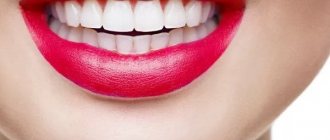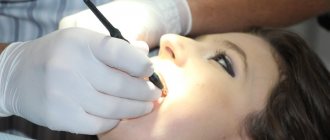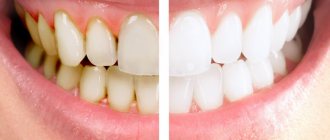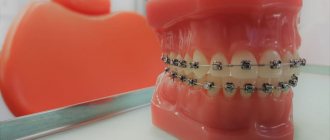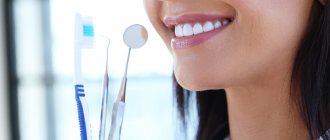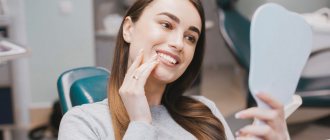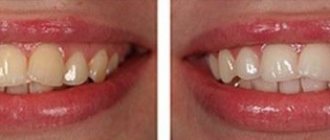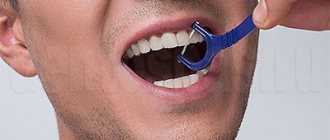Professional teeth cleaning is an oral care procedure aimed at preventing diseases of the teeth and gums. Plaque that appears on teeth in places inaccessible to brushing with a toothbrush gradually crystallizes into stones, which are located above and below the gum. The danger of such deposits is that bacteria accumulate and actively multiply in them. The ingrowth of tartar into the gum tissue can lead to various inflammations, increased tooth sensitivity, caries, periodontitis, and even loose teeth and tooth loss. Self-hygiene at home does not remove such plaque, so patients turn to dentists for help. Comprehensive oral hygiene or, in other words, professional teeth cleaning helps solve the problem.
How often should you have your teeth cleaned by the dentist?
It is recommended to have your teeth professionally cleaned by a specialist at least once every 6 months. This works for most, but some may need to visit the dentist more often.
The frequency of visits is based on the following factors:
- The presence of bad habits (for example, smoking, alcohol, frequent consumption of black tea or coffee and other enamel-staining drinks and food);
- features in the mineral composition of the saliva of a particular patient (the composition affects the different time of formation of stone on the teeth);
- how well the patient maintains oral hygiene (does he brush his teeth well, does he use dental floss and rinses);
- individual characteristics of the body.
There are patients who only need professional teeth cleaning once a year. At the same time, they themselves take quite good care of their teeth and gums. In any case, everything is individual, and it would be a good idea to ask your doctor how many times you need to have your teeth cleaned.
What does professional teeth cleaning include?
It consists of several stages:
- Using the Air Flow device, the doctor removes soft plaque from teeth and removes age spots from tea, coffee and cigarettes. Cleansing occurs by exposing the enamel to a strong jet of water, air and a special paste.
- Using an ultrasound machine, the doctor removes hard plaque and tartar. Special thin attachments allow you to remove both supragingival and subgingival deposits.
- To prevent new plaque from sticking to the teeth, the doctor polishes the enamel. After it, the surface of the teeth becomes less susceptible to dirt and plaque accumulation.
- At the end of the procedure, the doctor performs fluoridation - applies a special composition that strengthens the enamel and covers the teeth with a protective film. This composition stays on the teeth from one day to a week.
Is it important to brush your teeth “before” or “after” eating?
This is a question that is asked so often that the correct answer is lost even in the information masses.
After brushing your teeth before bed, provided that you did not get up for a “light night/evening snack,” you can leave your teeth brushing in the morning. During sleep, the sufficient amount of saliva necessary to rinse the oral cavity is suspended. Desquamated epithelium begins to accumulate in the mouth. It is found on the inner surface of the tongue, cheeks and lips. And it is also one of the reasons for the unpleasant odor. Before eating, rinse your mouth with water or mouthwash and drink a glass of water at room temperature. After breakfast, you should definitely brush your teeth. During the day, it is better to use rinses and dental floss to keep your gums clean and protect them from tartar formation.
Benefit
- After professional cleaning, enamel becomes smooth and better absorbs special substances and microelements contained in food and toothpaste.
- When plaque and tartar deposits are removed, the pathogenic environment that causes various inflammatory processes in the oral cavity is eliminated.
- Professional cleaning is indispensable for the prevention of diseases of teeth and gums. In particular, for gingivitis and some forms of periodontitis, it can be almost the only treatment that does not require other procedures.
- Bad breath goes away.
- Removing tartar and plaque improves the aesthetics of a smile: visually, teeth after cleaning look lighter - their natural shade returns.
How does plaque appear on the tongue?
Let's figure it out from the very beginning - the structure of the body. The tongue is your muscular organ that has a mucous membrane. The structure of the surface of the tongue determines how many bacteria will appear on it. These bacteria, in turn, are the cause of plaque and odor. As is correct, less plaque accumulates on the tip of the tongue because the tip of the tongue is cleaned using natural movement in the oral cavity. The back of the tongue is less mobile. Compared to the anterior one, it only comes into contact with the palate. It is also cleaned less thoroughly by the patient. Therefore, the plaque there is thicker. The reasons for the appearance of plaque on the tongue are obvious:
- Excessive alcohol consumption;
- tobacco and smoking;
- coloring matter from products;
- delay in treating infections;
- chronic diseases;
- stomach problems.
Why is it necessary to brush your teeth?
When you wake up, do you feel an unpleasant taste in your mouth? This is because small pieces of food get stuck between the teeth. Food debris affects the inflammatory process in the gums. By not brushing your teeth in the evening, you contribute to acid imbalance. During sleep, the regular production of saliva is suspended, which serves to further multiply bacteria.
Liquid intake also affects oral hygiene. For example, according to statistics, of all existing drinks, people most often drink black tea and strong coffee. Both drinks stain the enamel yellowish.
Why is it harmful to brush your teeth frequently?
Some people are convinced that the more often you brush your teeth, the better. Although this opinion is false. You should not clean the tooth surface immediately after eating, as the enamel during this period is weakened and susceptible to destruction. By cleaning, you can damage the surface of the enamel and create microcracks, into which bacteria can later enter, the proliferation of which can provoke various dental diseases. Also, if you brush your teeth frequently, you can damage your gums, which can trigger the development of inflammation in the periodontal tissues.
How to clean correctly
Brushing your teeth should take at least two minutes. At first, you can use a stopwatch to develop a habit. You need to brush your teeth with light, sweeping movements, paying special attention to hard-to-reach areas. Every area of the mouth should be thoroughly cleaned. The process of hygienic oral care can be divided into several stages of cleansing:
- The outer surface of the teeth first in the upper jaw and then in the lower jaw.
- The inner side of the teeth of the upper and lower jaws.
- Chewing surfaces of teeth.
- Surface of the tongue.
Some toothbrushes have a special surface on the back for cleaning the tongue.
The child has
Brushing your teeth in childhood is an important point, since habits formed in childhood most often contribute to the formation of the right attitude towards hygiene and your health in the future. Caring for children's teeth is slightly different from hygiene for adults. When your child's first baby teeth erupt, you should begin caring for them. To do this, you need to carefully wipe them with special sanitary napkins or gauze soaked in warm boiled water. You can also purchase special silicone brushes and pastes designed for babies that are safe to swallow. You need to start brushing your teeth once a day, gradually accustoming your child to the fact that the procedure is regular. Once your child gets used to it, you can add one more dental hygiene routine to the day. In adulthood, the hygiene process must be under the supervision of an adult in order to explain to the child the correct cleaning technique. It is extremely important that brushing teeth does not cause negativity in the child, for this you should come up with some kind of encouragement or incentive.
Myths about teeth
Myths about teeth brushing and whitening
1. Teeth can be whitened with a special toothpaste. This is wrong . Bleaching pastes containing abrasive materials can only remove staining from nicotine or food. Such toothpastes will not be able to make teeth whiter than they were intended by nature. Real teeth whitening is done only in dental clinics , using hydrogen peroxide or carbamide peroxide compounds.
2. To make your teeth whiter, you need to brush them with baking soda. In fact, soda has a very high abrasiveness, much higher than permissible. Therefore, brushing your teeth with soda will cause it to scratch and eventually remove the enamel of your teeth . Soda is contraindicated for any type of periodontitis.
3. Brushing your teeth is generally harmful, as it wears away the enamel. If you do not brush your teeth , soft plaque forms on them , which first contributes to the development of caries , and then the formation of tartar.
4. Teeth need to be brushed only 2 times a day. It's minimum. The amount of brushing depends on the nature of the food, the amount of plaque and the general condition of the body.
5. Brushing your teeth should be done after breakfast. Yes, you really need to brush your teeth after eating. But in the morning it is better to brush your teeth before eating , immediately after waking up - this prevents the bacteria that formed in the oral cavity overnight from developing and prevents bacteria from entering the stomach during meals.
Myths about toothache
6. If you have a toothache, apply cotton wool with alcohol or crushed aspirin to the tooth. It is very dangerous. This will not make a sick tooth feel any better, but if held for a long time, it will burn the mouth.
7. For toothache, you need to apply garlic to your wrist. This is how a certain group of sectarians were treated. Their faith in this method helped them. You can try it too.
8. If your teeth don’t hurt, then you don’t need to go to the dentist. As a rule, diseases of the oral cavity initially occur painlessly . In addition, in the early stages the disease is much easier to cure. Therefore, you must visit the dentist twice a year.
9. Any visit to the dentist is scary and painful. This is wrong. Dentistry today means modern treatment methods, clinics are equipped with silent devices and a variety of painkillers.
Myths about bite correction and braces
10. You can correct your bite at any age. This is only true if one or two teeth need to be corrected . If the bite is disturbed due to the characteristics of the maxillofacial apparatus, then each specific case should be discussed with an orthodontist.
11. The bite should be corrected after replacing all baby teeth with molars. It is better to visit an orthodontist when the child is three years old. If a child sucks a finger or pacifier for a long time, it is better to visit an orthodontist before the age of three. This will prevent the development of malocclusions and premature removal of baby teeth.
12. Correcting a child’s bite is expensive. There is some truth. The services of an orthodontist are not cheap. But if we take into account that an incorrect bite leads to a violation of the chewing function, therefore, disorders of the gastrointestinal tract, diseases of the teeth and gums, then by correcting an incorrect bite as early as possible, it will be possible to get by with small losses of money.
13. It takes a long time to get used to braces. This is wrong. Getting used to it lasts one to two weeks. In the first days after installation, pressure is felt on the teeth. Subsequently, braces do not interfere even when playing wind instruments.
14. Braces damage tooth enamel. Between the bracket and the tooth there is a special material that releases fluoride and strengthens the enamel. Tooth enamel can be worsened by insufficient hygiene when wearing braces or eating foods prohibited by the orthodontist. It is necessary to follow all the doctor’s recommendations and take care of your teeth more carefully than before installing braces.
15. Wearing braces is not attractive. It is much uglier to have uneven teeth. And you can choose braces to suit every taste - silver, sapphire, ceramic, plastic, lingual.
Myths about prosthetics and implantation
16. When installing a crown on a tooth, the nerve must be removed. Not anymore. Modern technologies in dentistry make it possible to treat a tooth and prepare it for prosthetics without resorting to nerve removal. When processing a tooth, a minimal amount of its tissue is removed, and after grinding the tooth is coated with a special agent that reduces its sensitivity.
17. Gold never causes allergies in the oral cavity. It is a myth. Everything is very individual . Some people may experience inflammation where gold crowns touch the oral mucosa.
18. It is not at all necessary to place an implant if there is no tooth. On the contrary, it is very necessary. When a tooth is missing, the bone tissue of the jaw deteriorates , pits and cavities form, the load on the remaining teeth increases, but the quality of chewing suffers, and this is fraught with diseases of the gastrointestinal tract. Well, in the end, a person with a full row of teeth has a more aesthetic appearance.
Myths about tooth extraction
19. It is cheaper to remove a diseased tooth than to treat it. It depends on situation. If there are no direct indications for tooth extraction, it must be preserved and cured. The tooth extraction itself can indeed be much cheaper, but as we have already stated above, there should not be empty spaces in the mouth. But dental implantation will still cost more than treating your own tooth.
20. A diseased tooth must be treated until the last minute and under no circumstances should it be removed. Of course, tooth extraction is far from the best option, but a diseased tooth is a source of infection , which also adversely affects the health of the body. Everything is very individual. There are cases when a seemingly non-viable tooth can be cured, but a seemingly healthy tooth has to be removed.
21. After tooth extraction, the oral cavity must be thoroughly disinfected. This is true, but you must not overdo it so as not to wash the blood clot out of the wound. It helps in better healing. So it’s better not to touch this place for 2-3 days.
Myths about treating children
22. Any dentist, not necessarily a pediatric dentist, can treat a child’s teeth. Treatment methods for children's and adult teeth are different. This is due to the presence of baby teeth in children and the resorption of their roots. And it is the pediatric dentist who is more qualified to possess this information. In addition, the cost of pediatric dentistry is cheaper.
23. It is necessary for the child to be afraid of dentists, then he will take better care of his teeth. There is a chance that the child will brush his teeth well often, but psychological fear of dental treatment will be more of an enemy than a helper . Because you will still have to treat your teeth sooner or later in life. It is better to visit the dentist with your child 2 times a year so that he gets used to the fact that this procedure is not scary, but necessary.
24. There is no need to treat baby teeth; they will fall out anyway. This is a very harmful misconception for children's health. Untreated baby teeth lead to problems with molars. Extracted baby teeth disrupt the bite prematurely.
25. Sweets are bad for your teeth. Not all sweets. Chocolate, for example, contains cocoa beans, which have an antimicrobial effect and protect teeth from caries. But this does not mean that you should not brush your teeth after eating chocolate or consume it in moderation. It is better to drink carbonated drinks through a straw to reduce the contact of the liquid with the enamel of the teeth.
Other myths
26. Traumatic periodontitis can occur only after an injury (bruise, blow).
The most common causes of this disease are not injuries, but, for example, regular pressure on the teeth from the mouthpiece of a smoking pipe or musical instrument. It’s also a good idea to get rid of bad habits - biting threads, pressing on a tooth with a pencil or pen, shelling seeds, etc.
27. Trigeminal neuralgia occurs during a cold. No. Trigeminal neuralgia is viral in nature and manifests itself as herpetic rashes on the skin of the face, although a cold provokes this disease. The first thing to do at the first signs of neuralgia is to get rid of the virus, i.e. if the disease becomes chronic, a post-herpetic pain phenomenon may develop, and it will have to be treated with anticonvulsants.
At what age should a child brush his teeth?
This question concerns all young fathers and mothers. What do experts say about this? Should children have their teeth brushed? Dentists offer two options:
- Children should begin oral hygiene procedures even before the first tooth erupts. Microorganisms accumulate both on the surface of the enamel and on the mucous membrane of the cheeks, gums, palate, and tongue. Therefore, young children, like adults, need hygiene. Cleaning the oral cavity should begin at 3-4 months of age. For this purpose, a special children's silicone brush is used, which is placed on the finger.
- Children need to brush their teeth after teething. This process is individual for each child, so it is difficult to give exact dates. There is no need to try to brush the tooth at the moment of its eruption; you need to wait until it is completely finished so that the child does not get hurt. After this, you can purchase a children's brush, which has bristles made of silicone and has a special stop. You need to start brushing your teeth without toothpaste.
Since there is no clear answer to the question posed, each situation must be approached individually. To begin, parents should consult with their pediatrician and pediatric dentist. Specialists will help you choose the optimal time to start oral hygiene procedures.
